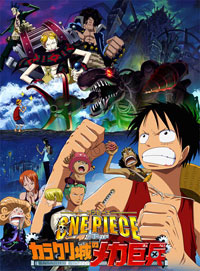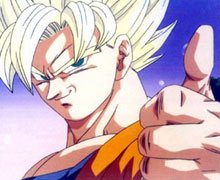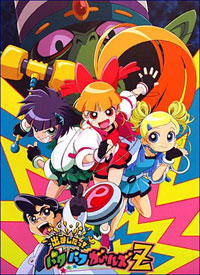Toei Animation Looks Back after Fifty Years
The Film Series > Shochiku Animation > Film Funding > Toei Animation > Film Commission > Tokyo Fest 2006
Anniversaries are important to the Captain. In fact, it was just last month that he opened a few cold ones to celebrate the eighty days that have passed since the statute of limitations expired on his most recent delinquent debt case.
 This week he picks up his drawing pen and takes a peek at cartoon studio Toei Animation after fifty years.
This week he picks up his drawing pen and takes a peek at cartoon studio Toei Animation after fifty years.
After a half-century in the cartoon business, in which it produced such television classics as "Sailor Moon" and "Dragonball Z," Toei Animation is returning to its roots.
"Our television animations are currently going all around the world," says Hiroyuki Kinoshita, director of the cartoon studio's corporate strategy. "Now we are thinking back to the origin of our company, which was focused on feature films."
Two Toei features, "One Piece: Karakuri Castle's Giant Mechanical Soldier," a swashbuckling search for lost treasure, and "Pretty Cure Max Heart 2," the sequel to last year's tale of three ladies charged with protecting a queen and her jewelry, hit screens across Japan in the last four months.
Emphasizing bigscreen is one way Toei is adapting to changes in the local market and taking advantage of the global popularity of animation, an industry worth $20 billion annually.
For the fiscal year ending March 31, Toei will have released five animated features, an increase over the three from the year before.
Japan's falling birthrate have spurred the company to try a new experiment: a love story blending live action with CGI animation. "The Last Love Song on This Little Planet," says Kinoshita, is seeking a slightly older audience than typical Toei fare like the ongoing "One Piece" series.
 "We are looking at a number of target audiences," he says, "as we try to capture different business opportunities for feature films."
"We are looking at a number of target audiences," he says, "as we try to capture different business opportunities for feature films."
But overseas expansion, explains Kinoshita, is Toei's biggest challenge. The international market for Japanese animation has received an enormous boost in recent years from the popularity of films by former Toei hand Hayao Miyasaki ("Howl's Moving Castle").
Toei recently opened branch offices in Europe, Latin America and Los Angeles as part of their overseas strategy of revitalizing existing titles and fostering such ancillary markets as merchandising. After suffering a steady decline for the past three years, overseas sales are projected to increase by more than 50% for the fiscal year ending in March.
On the TV side, the studio's upcoming collaboration with Cartoon Network will bring to televisions across the U.S. a Toei-animated version of the current cartoon "The Powerpuff Girls," a series where three ladies utilize light energy to morph into superheroines and ward off monsters from the dark side.
"We will be making something totally different," says Kinoshita of the difficulty in presenting a new version of an existing product. "Before that we were simply selling our productions to foreign companies."
Though these projects represent a change for Toei, the company's approach to financing its projects - roughly $2 or $3 million for a film and $100,000 for a television episode - has remained basically the same.
 Because of their higher cost, feature films require Toei to use the production-committee approach - the standard in Japan in which partner companies (such as a homevideo, toy, or publishing firms) invest in the production and share the profit.
Because of their higher cost, feature films require Toei to use the production-committee approach - the standard in Japan in which partner companies (such as a homevideo, toy, or publishing firms) invest in the production and share the profit.
"Television is different," says Kinoshita. "We will pay all the costs so that we can retain the distribution rights and character licensing business."
Toei is using new methods, though, to control costs. Since digital workstations have replaced traditional cel animation, a subsidiary in the Philippines with a staff of over 100 uses computers to perform much of the background and coloring work for Toei's television productions. The art direction and key animation elements are still completed in Japan.
This outsourcing of labor saves roughly $10,000 dollars per episode in manpower costs. But constant upgrades for the computer equipment are expensive, Kinoshita maintains, so the major benefit is simply that overall production costs remain in check.
With rival studio Shochiku having established an animation division in 2004, motivation to stay competitive is never in short supply at Toei's headquarters in Tokyo.
"Our philosphy," says Kinoshita, "is to provide dreams to children all over the world. That will not change. And when those children grow up to become adults, we will have to ensure that they too are satisfied."
Note: This story originally appeared in the March 27-April 2 issue of Variety.
The Film Series > Shochiku Animation > Film Funding > Toei Animation > Film Commission > Tokyo Fest 2006

